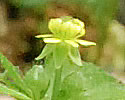Ranunculus recurvatus (Hooked Buttercup)
| Also known as: | Blisterwort, Hooked Crowfoot |
|---|---|
| Genus: | Ranunculus |
| Family: | Ranunculaceae (Buttercup) |
| Life cycle: | perennial |
| Origin: | native |
| Habitat: | part shade; average to moist woods, along streams, edges of swamps, floodplains |
| Bloom season: | May - June |
| Plant height: | 1 to 2 feet |
| Wetland Indicator Status: | GP: FACW MW: FACW NCNE: FACW |
| MN county distribution (click map to enlarge): |  |
| National distribution (click map to enlarge): |  |
Pick an image for a larger view. See the glossary for icon descriptions.
Detailed Information
Flower: 
![[photo of flowers]](/udata/r9ndp23q/yellow/hooked-buttercup-100_6136-t.jpg) Flowers are at the end of stalks that arise from the upper leaf axils. Flowers are ¼ to ½ inch across, 5 narrowly triangular to oblong, pale yellow petals and about 20 yellow-tipped stamens surrounding a bright green center. The 5 yellowish-green sepals are about as long as the petals, or a little longer, and typically bend back away from the flower (reflexed).
Flowers are at the end of stalks that arise from the upper leaf axils. Flowers are ¼ to ½ inch across, 5 narrowly triangular to oblong, pale yellow petals and about 20 yellow-tipped stamens surrounding a bright green center. The 5 yellowish-green sepals are about as long as the petals, or a little longer, and typically bend back away from the flower (reflexed).
Leaves and stem: 


![[photo of leaves]](/udata/r9ndp23q/yellow/hooked-buttercup-100_6138-t.jpg) Leaves are basal and alternate, up to 4 inches long and 3 inches wide, lobed or deeply divided into 3 or 5 parts, with long leaf stalks that become shorter as leaves ascend the stem. The lobes are coarsely toothed toward the tip end and may be further divided with more shallow lobes. Stems and leaf stalks are both hairy, and the leaves may also have scattered hairs on the surfaces, and fine hairs along the edges. Stems are erect, branched, and do not root at the nodes.
Leaves are basal and alternate, up to 4 inches long and 3 inches wide, lobed or deeply divided into 3 or 5 parts, with long leaf stalks that become shorter as leaves ascend the stem. The lobes are coarsely toothed toward the tip end and may be further divided with more shallow lobes. Stems and leaf stalks are both hairy, and the leaves may also have scattered hairs on the surfaces, and fine hairs along the edges. Stems are erect, branched, and do not root at the nodes.
Fruit: 
![[photo of fruit]](/udata/r9ndp23q/yellow/ranunculus-recurvatus-hooked-buttercup_0609_190933-t.jpg) The flower center expands into a round seed head about ¼ inch in diameter. Seeds are smooth with a hook at the tip of the beak, which is where the common name originates.
The flower center expands into a round seed head about ¼ inch in diameter. Seeds are smooth with a hook at the tip of the beak, which is where the common name originates.
Notes:
The flowers of Hooked Buttercup are unique enough to distinguish it from other Ranunculus species with small yellow flowers. There are two varieties but one is limited to tropical climates, leaving var. recurvatus inhabiting Minnesota and much of the eastern half of North America
Native Plant Nurseries, Restoration and Landscaping Services ↓
More photos
Photos by K. Chayka taken at Wild River State Park, Chisago County, and in Ramsey County.
Comments
Have you seen this plant in Minnesota, or have any other comments about it?
on: 2011-05-24 17:34:12
Found this plant growing in my wooded back yard in Eagan, Mn. It is slightly common. Have been waiting for 3 weeks for it to bloom so I could identify it. Nice foliage which will provide added green in the summer months as I remove the buckthorn and boxelder shoots.
on: 2018-06-24 21:22:36
Just one plant near the house.
on: 2021-10-21 15:08:02
Growing in a shady shallow ditch beside our driveway. The lobes on mine are much shallower than shown in the photos on this page.
on: 2023-04-29 10:41:24
Why is it called blisterwort?
on: 2023-04-29 10:45:20
Robin, rumor has it the sap, which contains toxins, may cause lesions and blisters.
on: 2023-05-02 14:36:43
Is this plant the source of the annoying burrs that get in my dog's fur in the late summer and fall?
on: 2023-05-02 14:45:03
Gabrielle, there are many plants that produce barbed fruits, but this one isn't particularly troublesome. As far as woodland species go, stickseed and enchanter's nightshade are worse offenders.







 Hooked Buttercup plant
Hooked Buttercup plant plant just starting to bloom
plant just starting to bloom more flowers
more flowers